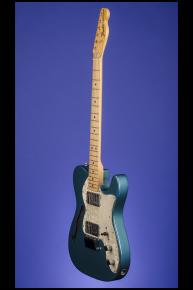Custom Color, Two Humbucker Telecaster Thinline
1972 Fender Telecaster Thinline
This super light, custom color, Telecaster Thinline is in exceptionally fine condition and weighs just 6.40 lbs! Twelve and three-quarter inch wide, one and seven-eighths inch thick, hollow ash body with a single 'f' hole on the bass side. One-piece fretted maple neck with a nut width of just over 1 5/8 inches and a wonderful medium-to-thick 'C' shaped 7 1/4 inch radius fretboard with twenty-one original medium frets and black dot position markers. Headstock with "Fender" logo in black with gold trim, with two patent numbers ("2,573,254 3,143,028") in black below. "Telecaster" in black in bold letters beside it, with "Thinline" in black below. Two "butterfly" string trees, one with a nylon spacer. Individual Fender "F" tuners with octagonal metal buttons. Three-bolt 'microtilt' neck plate with serial number "380749" stamped between the top two screws. Two fully adjustable Fender 'Seth Lover' metal-covered split-pole-piece humbucker pickups with outputs of 9.88k and 10.32k. Three-layer pearloid (mother-of-toilet seat) over black and white pickguard with fifteen screws. Two controls (one volume, one tone) plus three-way selector switch, all on pickguard. The potentiometers are stamped "137 7218" & "137 7221" (CTS, May 1972). Chrome knobs with flat tops and knurled sides. Fender fully adjustable six-saddle combined bridge/tailpiece. The end of the neck is stamped in black "3 DEC 72B". The underside of the neck is also stamped in black "X Armenta" and "Frank V". The neck pocket is stamped in black "Ayala" and the neck pickup cavity is stamped in black "Gabe". There are two areas where the pickguard is cracked due to the inevitable shrinkage, one by the treble horn, the other by the tone control. There is no lacquer checking on the body and the Lake Placid Blue finish is bright and vibrant with no discoloration or fading whatsoever. The first few original frets show some very slight playing wear but there is virtually no wear to the fretboard. There are four very small surface chips, two on the lower edge and two on the top edge of the body and a few very minor surface marks or scratches (nothing through the finish) mainly on the edges of the body. This wonderful and rather rare custom color guitar is 100% original and is in exceptionally fine (9.00) condition. Complete with the original 'ash-tray' bridge cover. Housed in the original Fender three latch rectangular black hardshell case with black leather ends and reddish orange plush lining (9.25).
Very few Custom color Telecaster Thinlines were produced and consequently they are now quite rare - this is the first LPB Thinline that we have offered for sale.
"Introduced in 1968, this model was an attempt by Fender to reduce the weight of the solid Telecaster by hollowing out sections of the body -- and the guitar even included a token f-hole as a visual clue to its semi-solid status. The Thinline at first retained the standard Tele pickup layout, but with a restyled pickguard" (Tony Bacon and Paul Day, The Fender Book, p. 47).
"The Telecaster Thinline was "basically a Telecaster body with pockets hollowed-out from the rear, including a bigger one opening into the top via an 'f' hole. With the exception of the pickguard shape modified to accommodate the new semi-acoustic design, the Thinline was otherwise identical to a regular '68 Telecaster in terms of neck, electronics and hardware. But its body was about half the weight of a regular Telecaster. The new variant was first listed in July 1968 for $319.50…To convey the idea of a lighter, almost acoustic guitar, the Thinline was at first released in only natural ash and mahogany finishes with a 2-piece maple neck… By 1969, it also became available with a 3-tone sunburst finish and an optional rosewood-capped neck."
"The 60s blues boom and the ensuing transition towards heavy rock gave exposure to Gibson-type double coil humbuckers because of their sustain and weeping tone. As Fender later claimed in a 1972 leaflet: "Humbucking pickups eliminate feedback and add a gutty mid-range and bass sound." In the late 60s however, the Fender sound was mostly associated with bright sounding single coil units and CBS Musical Instruments felt the commercial need to enlarge its pickup offering. Meanwhile, Seth Lover, the man who had designed Gibson's famous humbucker in the mid-50s, resigned from his job at Kalamazoo in 1967. When Dick Evans, a former Gibson employee then working in Fullerton, heard of Seth's resignation he invited him to California. Guess what happened: Seth Lover was hired by Fender and he subsequently designed the company's first double coil pickup (available in a guitar and bass version)."
"Compared to a classic late 60s humbucker, the new Fender unit was primarily characterized by twelve adjustable cunife magnets and a mega output (DC resistance > 10k Ohms). Seth Lover's new humbucking pickup was finalized in the course of 1970 and first appeared on Fender instruments after mid-1971. Telecaster guitars were initially the sole recipient of the newly designed pickup, also fitted later to the short-lived Starcaster. By the end of 1971, The Thinline was thus revamped with two humbuckers and a Tilt Neck. The second variant of the semi-acoustic model, first listed in February 1972, otherwise incorporated a modified pickguard, a 6-piece Strat-style bridge and a "Thinline" decal on the upper bout of the headstock. At first it retained the same basic finishes as the original Thinline, i.e. Ash, Mahogany and Sunburst, but very few were actually made in mahogany before this finish was dropped." (A.R. Duchossoir, The Fender Telecaster, pp. 23-25).












